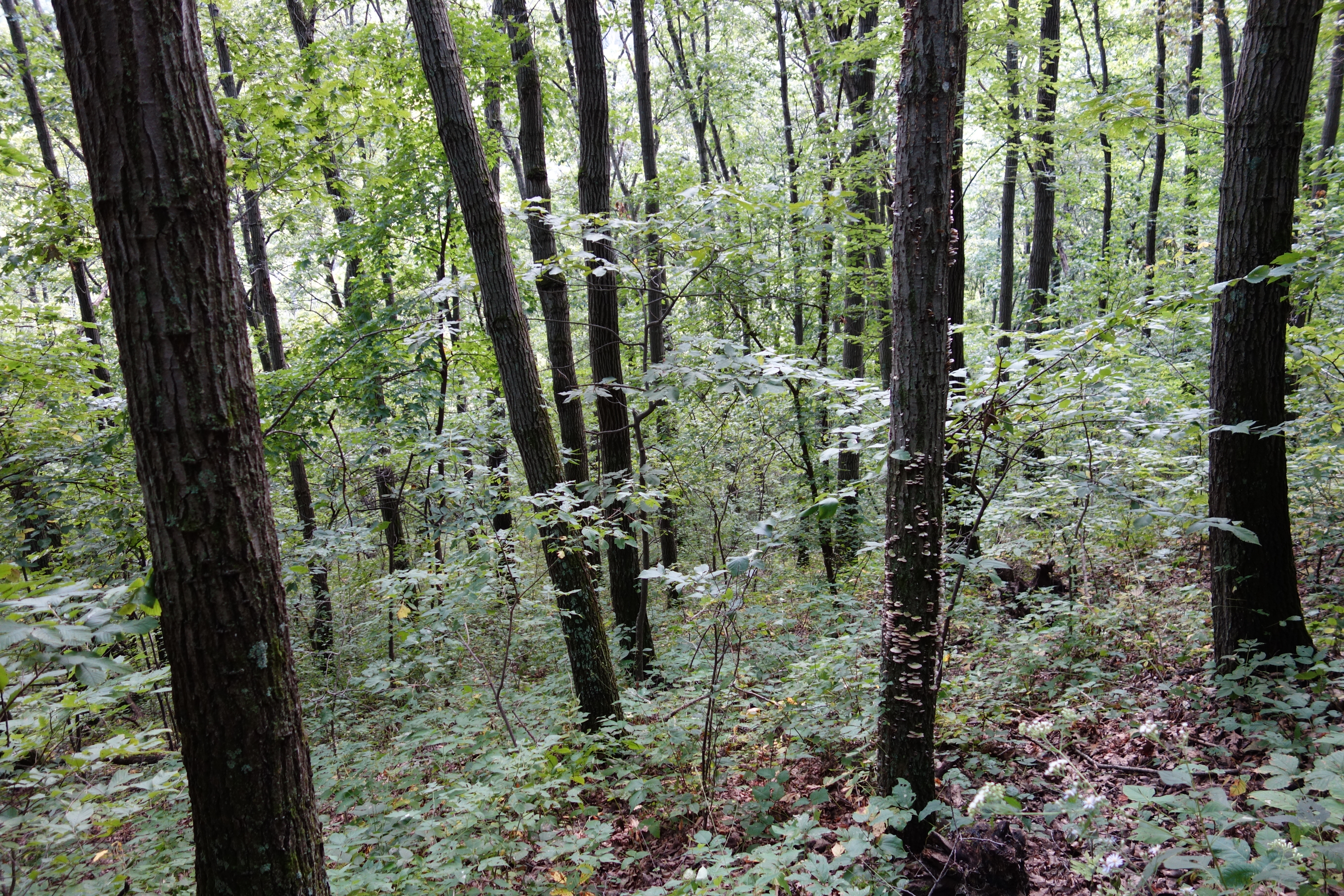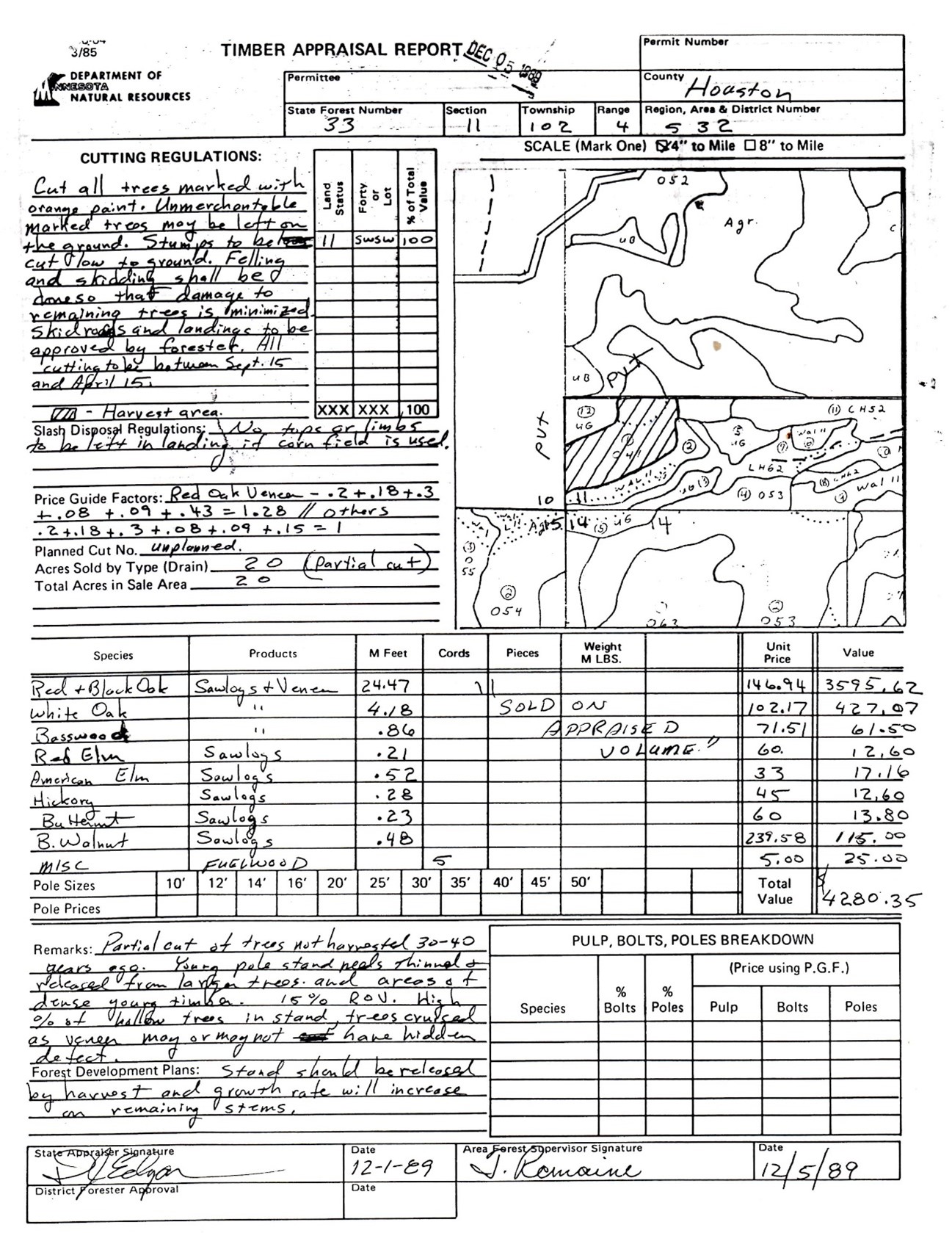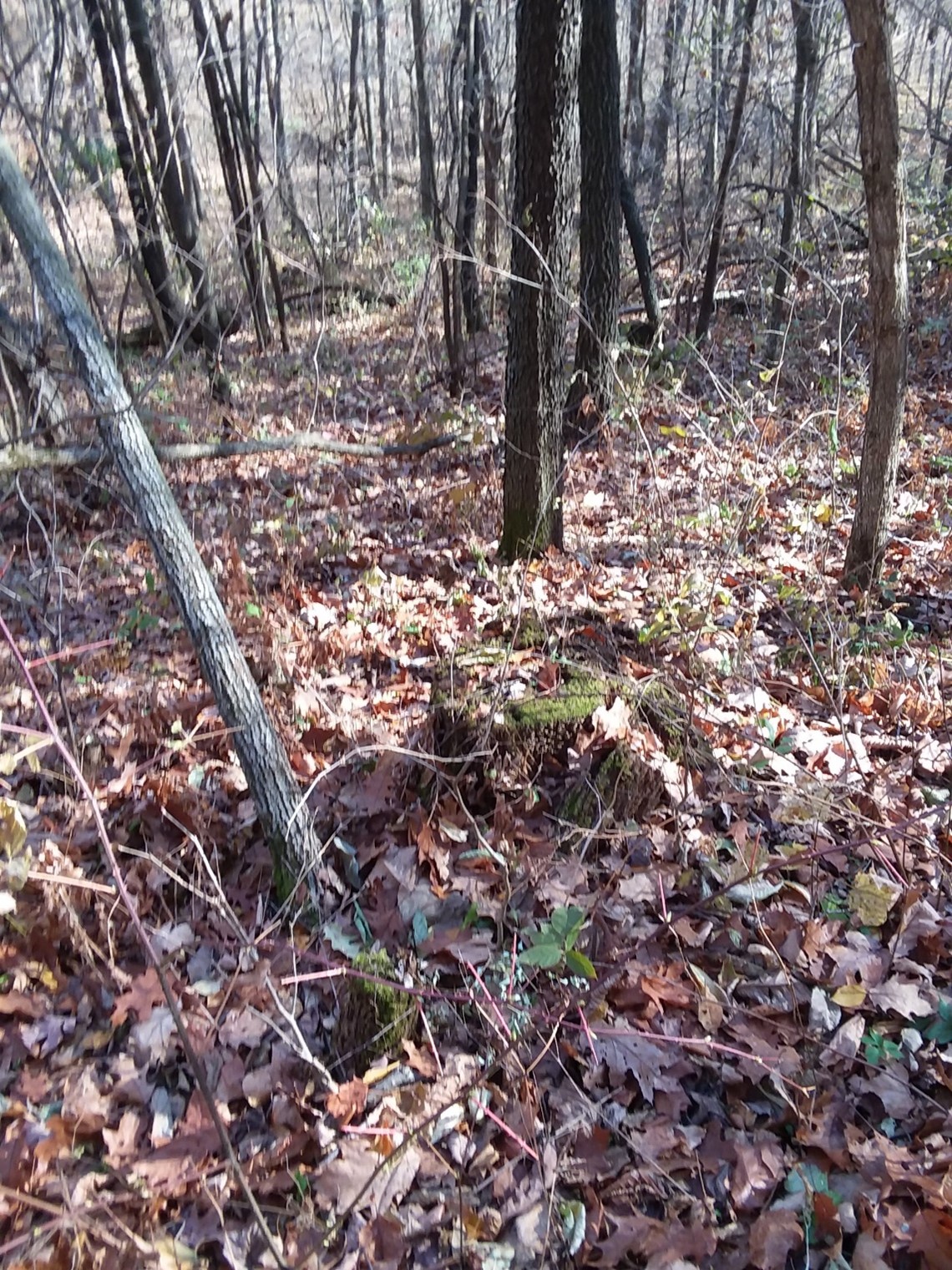Overview
The subject of this case study is a successful red oak stand improvement project initiated on a stand with oak trees of two age classes.
The native plant community silvicultural strategy employed was for maintaining MHs37 forests as would natural senescence, disease, or selective windthrow with small gaps. The older/larger sawlog sized trees were harvested in 1990 to release the younger, pole-sized trees. A follow-up “crop tree release” to kill boxelder, elm and ironwood and basswood competing with oaks was done in 2014. Timber quality, stand health and wildlife habitat have all been improved.
We especially want to highlight the timber quality improvement in this study because of its importance to achieving good forest management, including habitat improvement. Specifically: since we do most forest management through commercial timber harvest, improving timber value and marketability of a stand can improve forest management opportunities. Hardwood marketability factors for this stand such as species composition, size and form of trees were improved. Additionally, the amount of oak with healthy crowns for mast production is a plus for many wildlife species that utilize acorns for food.
The result in 2020 is a two-aged oak stand dominated by approximately 78-year-old red oak, with modest volumes of 100 plus year-old red oak, as well as small components of white oak, basswood and hickory. The oaks have healthy crowns, and many have very good timber quality.
Details on stand composition, timber quality, growth response, management practices, costs and revenue are presented in the study.

Figure 1: Approximately 78 year old red oaks.
Silviculture Objective(s)
1) Improve timber quality and value. A good component of healthy, well-formed oaks will help ensure high timber value and enable future management through commercial harvest.
2) Maintain and improve wildlife habitat by increasing the component and crown size of oak trees in the new stand. Oak forests provide habitat for numerous wildlife species. The principal game species include white-tailed deer, turkey and gray squirrels, and in some areas ruffed grouse. Other important species include raccoon, opossum, red fox, bobcat, skunk, and a host of birds. One of oaks’ most important contributions to wildlife is mast, or acorns which are an important seasonal food source for squirrels, turkey, deer, grouse, blue jays and other acorn consumers. Source: North Central Manager’s Handbook for Oaks in the North Central States (GTR NC-37).
Pre-treatment stand description and condition
Stand establishment and management history:
Based on the aerial image from 1938 shown in Figure 4, it appears that the stand was heavily pastured, consisting of mostly open grassland, with several patches of overstory trees (probably mostly oak). It also may have been burned periodically, which was common practice at that time. Fire scars from the periodic burning may have been a major cause of the heart rot noted in the 1989 timber sale appraisal.

Figure 3: 2019 color IR aerial photo of case study site and surrounding area.

Figure 4: 1938 black and white aerial photo of study site and surrounding area.
Therefore, before the first thinning was done in 1990, the stand had trees of two age classes – the patchy, scattered overstory oaks that were present in 1938, and the pole-sized oaks that became established some time fairly shortly after 1938, when the heavy pasturing ceased.
Pre-treatment species composition:
Before initial treatment in 1990, the stand was a two-aged pole to sawlog-sized oak stand. It was dominated by northern red, black and white oak, with modest volumes of bur oak, basswood, elm, hickory and several other minor species.
A note on the 1989 timber sale appraisal indicates that the stand had been harvested 30 to 40 years previously, prior to state ownership.
Table 1: 1989 Timber Sale Appraisal of Volume to be Thinned
|
Species and Product |
Volume |
|
Red & Black Oak Sawlogs and Veneer |
24,500 Board Feet |
|
White Oak Sawlogs and Veneer |
4,200 Board Feet |
|
Basswood Sawlogs and Veneer |
900 Board Feet |
|
Elm Sawlogs |
700 Board Feet |
|
Black Walnut Sawlogs |
500 Board Feet |
|
Hickory Sawlogs |
300 Board Feet |
|
Butternut Sawlogs |
200 Board Feet |
|
Total |
31,300 Board Feet |
Pre-treatment growth and stocking:
Site productivity for tree growth of the site varies. While oak establishment is generally easier on drier west and south-facing slopes with shallower soils, the best sites for growing high quality oak occur on north- and east-facing shoulder or toe slopes that have soils that are at least 30 inches deep. The study site itself is on steep east to southeast-facing slopes that grade into more gentle slopes at the top and bottom.
Pre-treatment forest health issues:
The 1989 timber sale appraisal notes that the stand had a significant amount of heart rot, probably due to a history of pasturing and perhaps periodic burning.
Landowner objectives/situation:
While specific objectives vary from parcel to parcel, lands under the administration of DNR-Forestry are managed in alignment with Section Forest Resource Management Plans (SFRMP) to ensure that state forest management activities meet statewide goals for ecological protection, timber production, wildlife habitat and cultural/recreational values. The DNR assembles teams from the Divisions of Forestry, Fish & Wildlife, and Ecological & Water Resources who work with partners and the public to develop SFRMPs.
The Minnesota DNR landscape goal for oak forest acreage was to maintain as much of it as possible or increase where feasible.
Silviculture Prescription
The following series of treatments were implemented:
|
Treatment |
Date |
Description |
Acres Treated |
|
Commercial Thinning Harvest |
1990 |
Commercial thinning to improve stand composition, growth, health and timber quality of a 2-aged stand. Most of the larger, older, sawlog-sized trees were harvested to release crowns of younger, pole-sized oaks that were retained. |
18.5 |
|
Timber Stand Improvement and Crop Tree Release |
2014 |
Trees of lower timber value such as hickory, basswood and elm that were competing with healthy oaks were killed by girdling them and treating the girdle wounds with herbicide. Killing these lower value species opened crowns of retained oak crop trees to more sunlight. |
18.5 |
What actually happened during the treatment
Nothing more than listed above. Things went pretty much according to plan.

Figure 5: Timber appraisal for 1990 commercial thin.
Post-treatment assessment
A primer on timber quality and market value
Before we get into specifics of assessing results of current stand condition and results of the silvicultural activity as of 2020, we need to spend some time understanding the basics on hardwood timber value.
Appearance drives value: Hardwoods are most commonly used in products such as furniture, where appearance is the driving factor in determining value. Larger, straighter, trees with few limbs on the lower bole and little or no rot produce boards with few appearance defects such as knots, and are therefore worth more money. Species is also a huge factor driving market value, and red oak is consistently one of the highest demand species in the hardwood marketplace.
Hardwood log grading as a timber quality assessment: Hardwood log grades are used during timber appraisal as a means to assess a tree’s value based on its fit for various hardwood markets. The most valuable trees are those that will produce a large volume of wood that is straight, clear, with few or no appearance defects such as knots or seams. Higher-grade hardwood logs command a premium price in comparison to lower grade logs and other fiber products of the forest. Table 2 below shows the specifications that Minnesota DNR uses for grading hardwood trees during timber sale appraisals.
Table 2: Minnesota DNR Hardwood Tree Grades
|
Log Grade |
Position in Tree |
MIN Tree DBH (Inches) |
MIN DIB Small End (Inches) |
MIN Length w/o Trim (Feet) |
Sweep/Crook (% DIB) |
|
Prime |
Butts Only |
21 |
16 |
8 |
10% |
|
Select |
Butts Only |
16 |
12 |
8 |
10% |
|
#1 |
Any |
16 |
12 |
8 |
15% |
|
#2 |
Any |
14 |
10 |
8 |
25% |
|
#3 |
Any |
14 |
10 |
8 |
25% |
With a very basic understanding of hardwood markets and timber value, we can now look at specifics for this stand.
Stand timber quality, revenue and forest management potential were improved
Timber quality assessment: While the lack of a similar pre-treatment measure of timber quality makes direct comparison impossible for this study, we still wanted to assess timber quality as both a general measure, and as a way to enable direct comparisons to different sites on the same plant communities in the future. Since a site’s ability to grow high quality hardwood timber is greatly impacted by plant community, we tracked grade by the two NPCs (Native Plant Communities) on this site. The MHs37 plant community with the east-facing slope clearly had higher quality timber.
Table 3: Tree grades for eight randomly selected oaks in 2020
|
Plot |
Species |
DBH |
NPC/Aspect |
Grade |
Notes |
|
1e |
Red oak |
24” |
MHs37/East |
1 |
3 clear faces |
|
3e |
Red oak |
15.8” |
MHs37/East |
1 |
4 clear faces |
|
9e |
Red oak |
22.5 |
MHs37/East |
Prime |
4 clear faces |
|
5e |
Black oak |
15.1 |
MHs37/East |
3 |
No clear faces |
|
12se |
Red oak |
16.4” |
FDs38/Southeast |
3 |
No clear faces |
|
8se |
Black oak |
19” |
FDs38/Southeast |
3 |
No clear faces |
|
3se |
Black oak |
16.3” |
FDs38/Southeast |
3 |
No clear faces |
|
6se |
Black oak |
16.7” |
FDs38/Southeast |
3 |
No clear faces |
Stand timber quality and value was improved for the whole stand
While an exact measure of the amount of post-treatment improvement is not possible, we can say empirically that quality of oak timber in the stand is now better than average, and that it improved since 1990. The forester that designed and administered the commercial thinning harvest in 1990 noted at the time that there was more than an average amount of heart rot present. He also noted that stand had been harvested 30 to 40 years before, when the property was in private ownership. Most timber harvesting in southeastern Minnesota in that time period of the 1950s to 1960s focused on the highest quality trees, leaving the smaller and lower timber quality trees behind. It is therefore reasonable to conclude that timber quality before the improvement work started in 1990 was average or below.
Growth on oak crop trees and mast production were increased
Both of the stand improvement thinnings resulted in increased growth of crop trees. This resulted in more timber value by concentrating more of the stand’s growth into the most valuable timber trees. It also probably had wildlife habitat benefit through increased mast production from larger, healthier crowns in oak crop trees.
We took increment core samples from eight randomly selected trees to measure growth response to the two thinning practices done over the past 30 years. The strong growth response to thinning, especially by younger trees with good crowns can be clearly seen by wider annual rings in tree cores. See Figure 2 (link below), a photo of the tree core for sample number 5 and Table 4, ring counts and tree condition for cored trees.

Figure 2: Tree core for sample #5 showing thinning growth response
Table 4: Ring count at DBH, and tree condition for five cored red oak trees
|
Tree Number |
DBH (inches) |
Number of Rings to Center* |
Waypoint Number |
Treatment Class |
Condition Class |
Residual Basal Area of Trees of Equal or Greater Diameter (Ft2/ac.) |
Live Crown Ratio |
Notes |
|
1 |
16.2 |
73 |
408 |
Thin |
Apparently Healthy |
30 |
30% |
Thinning growth response very clear |
|
2 |
16.7 |
131 |
409 |
Thin |
Apparently Healthy |
40 |
50% |
|
|
3 |
19.3 |
102 |
413 |
Thin |
Apparently Healthy |
0 |
30% |
|
|
4 |
13.9 |
72 |
417 |
Thin |
Apparently Healthy |
40 |
20% |
Thinning growth response fairly clear |
|
5 |
16.3 |
72 |
418 |
Thin |
Apparently Healthy |
20 |
30% |
Thinning growth response very clear |
*add 6 years to the ring count (for seedlings to reach (DBH) to get an estimated total tree age.
Stand composition and structure
As of 2020, the two improvement thinnings have resulted in a two-aged oak stand dominated by approximately 78-year-old red oak, with modest volumes of 100 plus year-old red oak, as well as small components of white oak, basswood and hickory. The oaks have healthy crowns, and many have very good timber quality.
Overstory
As shown in table 5 (link below), red oak has by far the greatest basal area and frequency on plots of any species. Shagbark hickory, white and bur oak, black walnut and several other species are also present in moderate to small amounts. This stand should be ready for a regeneration harvest any time in the next 15 years or so.
Table 5: Tree species basal area in feet2/acre by DBH class and frequency on plots in 2020

Regeneration
Regeneration data is shown in Table 6 at the link below. On this site, probably two items are of greatest interest to the future management of the stand. The data for these two items shows some implications for their potential impact on the stand moving forward. They are:
- Small (3 – 5 inch DBH) trees in midstory: there are modest components of elm and hackberry, and very small components of basswood, shagbark hickory and butternut that form a midstory. These trees provide some beneficial diversity to the stand, without having significant impacts to future oak regeneration efforts. The elm component is higher than desired, but elms could be controlled in a future crop tree release project if desired.
- Sugar maple of all sizes: because of its shade tolerance, sugar maple has potential to outcompete sun-loving oaks over time if not managed carefully. Small sugar maple regeneration was present on every plot. This will need to be carefully monitored and factored into any future stand re-initiation oak regeneration work for the stand. Specifically, when the mature stand is re-initiated, actions to control maple competition would be needed to enable oak regeneration to thrive.
Table 6: Stems per acre of regeneration by species, size class, and plot frequency in 2020

A note of explanation on regeneration data gathered: Because their impact on the future management of the stand is likely to be negligible, we did not collect data for the “regenerant” or “seedling” size classes for any species except sugar maple. For sugar maple, we were not confident that we could get accurate numbers for the small regeneration due to difficulty in identification since leaf drop was in progress. Therefore we only recorded presence or absence of regenerants and seedlings for sugar maple, not exact numbers.
Plant diversity
In terms of plant diversity, we found a pretty typical suite of native ground flora and shrubs on site that commonly occur in MHs37 and FDs38 plant communities.
Invasive Species
We did note some buckthorn on site. Some Japanese barberry and exotic honeysuckles were treated and killed as part of the timber stand improvement work done in 2014.


Figure 7: Looking up in 2020. Crowns have mostly filled in after the 1990 and 2014 thinning.

Figure 8: Jim Edgar near a red oak

Figure 9: A stump from the 1990 commercial thinning harvest surrounded by released trees in 2020
Plans for future treatments
Monitor the stand through periodic inventory surveys. Harvest and regenerate the stand when it is chosen in the planning process.
Costs and economic considerations
Costs
Thinning harvest 1990: $ 80/ac (1990 dollars)
Non-commercial crown thinning 2014: $ 213/ac (2014 dollars)
-----------
TOTAL $ 293/ac (1990 and 2014 dollars)
Revenue
Harvest on 18.5 acres (1990) $ 231/ac. (1990 dollars)
-----------
TOTAL: $ 231/ac. (1990 dollars)
Other notes
We gratefully acknowledge the editorial assistance provided by Minnesota DNR Silviculture Program Leader Mike Reinikainen.
This case study was developed with support from the United States Department of Agriculture's National Institute for Food and Agriculture, Renewable Resources Extension Act. Project #2021-46401-35956, principal investigator Eli Sagor, University of Minnesota.
Summary / lessons learned / additional thoughts
Intermediate thinnings improved timber volume and quality, revenue potential, tree health and vigor and wildlife habitat in this oak stand.
The silvicultural work done over the past 30 years have been a “win” for the citizens of Minnesota. The result is a stand that:
- Is healthy. Trees have healthy crowns, good growth and there are no notable insect, disease issues.
- Has good timber value. The high oak component and above average timber quality mean that the stand should be very marketable and the State of Minnesota should obtain good revenue at sale time.
- Has good wildlife value. The high oak component and healthy crowns mean that mast production is plentiful.
- Has good forest management potential. High timber value will enable management through commercial timber harvest. The relatively low and manageable amount of competing shade-tolerant tree species such as sugar maple and basswood mean that oak regeneration will be a realistic option when the stand is harvested and regenerated.
